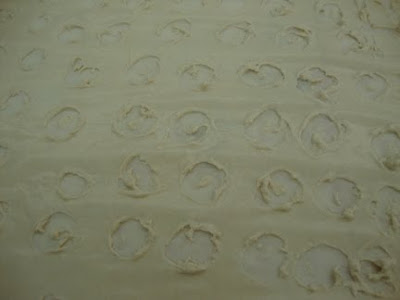
Some time ago I did a couple of pieces using Flour Paste as a resist. I loved the results but the paste itself was difficult to apply and the window for application was very short. You can see those results Here. Next I tried a Potato Resist which also gave good results but I found it just seemed unnecessarily messy to apply, especially if you wanted to spread it to a large area.
Both of these resists give interesting results so I was interested when I read an article on my friend Judi Hurwitt's blog. Judi has been experimenting with this paste and gave the formula in a recent article so I decided to give it a test.
Judi's formula is: 2 cups water to 1 cup flour. Whisk these together and apply.
I like to work large so I laid out a piece of fabric that was 45" x 45" expecting to use part if not all. In light of this, I doubled the amounts of water and flour to:
4 cups water
to
2 cups flour
The ingredients blended together nicely but I felt it was too watery so I added additional flour until it was like thin pancake batter. I estimate that I added 1 additional cup.
The fabric had been soda soaked and dried and was then pinned to a fabric covered support board. I applied the paste to the fabric by pouring across a width of about half the fabric and then spread it with my trusty bondo scraper. Working my way across and down the fabric, this amount of paste covered an area of 29" x 45". Because the paste is so fluid it would be possible to mix and continue to cover your fabric if you choose to do so.
This mixture was a pleasure to spread. It is easy to create thick and thin areas and I could see that the fabric underneath was already absorbing the water from the resist so I knew it would dry quickly. After the paste was applied I used a chopstick as a drawing tool and drew into the paste. As predicted, it was drying fast and I worked quickly to make my marks. It is not an issue of not being able to continue to draw into the paste but it does start pulling up off the fabric as it dries more.
Marks in wet resist
Marks in wet resist
Marks in wet resist
I left this in an unheated studio with a fan positioned to aid the drying and by the next day it was dry to the touch. I did leave it until the afternoon before I applied dye. The surface is really beautiful. It is smooth and leathery where there were no marks and a great ivory color. There was only a small amount of crazing so I did scrunch the fabric up some to add cracks.
I mixed a medium shade of moss green and thickened it with print paste. This was brushed onto the surface. The application on this surface was much easier than onto my first flour resist piece.
Thickened dye applied to dried resist.
Thickened dye applied to dried resist.
Thickened dye applied to dried resist.
Again, this dried very quickly. It took only about 24 hours to dry. I did check the back to see how the dye had penetrated the surface and decided to pick off some of the flour resist and apply more dye. In the final piece you can see some larger areas of the green and these are the areas I opened for more dye absorption.
I only waited 4 hours before removing the resist and dye. I loved the surface on the piece and would have just left the paste on if possible. At this point I am not sure if I will add more color to the fabric, try to finish the piece as a whole cloth composition or cut it into pieces to be used in other compositions. I will definitely use this resist again and this study proved that experimentation is often required to get a mixture adjusted to a usable state.
Thank you for stopping by and I love to hear your comments. Please, if you try this resist , let me know how it works for you.





